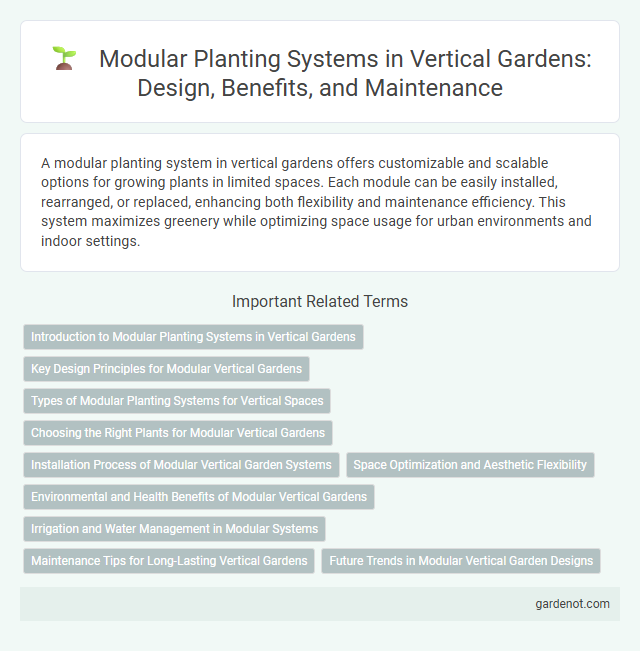A modular planting system in vertical gardens offers customizable and scalable options for growing plants in limited spaces. Each module can be easily installed, rearranged, or replaced, enhancing both flexibility and maintenance efficiency. This system maximizes greenery while optimizing space usage for urban environments and indoor settings.
Introduction to Modular Planting Systems in Vertical Gardens
Modular planting systems in vertical gardens offer a flexible and scalable solution for urban greening, allowing individual planting units to be easily installed, replaced, or rearranged. These systems enhance plant health and growth by optimizing soil volume and irrigation management tailored to each module. Modular designs support diverse plant species, improve space efficiency, and simplify maintenance, making vertical gardens more accessible and sustainable.
Key Design Principles for Modular Vertical Gardens
Modular planting systems for vertical gardens emphasize scalability, allowing users to expand garden size by adding uniform, interconnected units. Key design principles include efficient water distribution, ensuring each module receives adequate hydration through integrated irrigation channels. Durable, weather-resistant materials combined with easy installation methods enhance longevity and user accessibility in diverse environmental conditions.
Types of Modular Planting Systems for Vertical Spaces
Modular planting systems for vertical gardens come in various types, including panel systems, pocket systems, and tray systems, each designed to optimize space and plant diversity. Panel systems use flat, rigid panels with integrated planting compartments, ideal for uniform and structured layouts. Pocket systems consist of fabric or felt pouches that hold soil and plants, offering lightweight and flexible arrangements, while tray systems use individual containers for easy customization and maintenance in vertical spaces.
Choosing the Right Plants for Modular Vertical Gardens
Selecting plants for modular vertical gardens requires consideration of growth habits, light requirements, and maintenance needs. Succulents, ferns, and trailing vines like pothos or philodendron thrive in modular systems due to their adaptability and low water demand. Incorporating a mix of flowering plants and evergreens enhances aesthetic appeal while ensuring year-round greenery.
Installation Process of Modular Vertical Garden Systems
Modular vertical garden systems feature lightweight, interlocking panels designed for easy installation on walls or fences, minimizing structural modifications. The process typically involves mounting a frame, attaching modules with integrated irrigation channels, and filling cells with soil and plants tailored to the environment. This approach enables rapid assembly, efficient water management, and scalable customization for both residential and commercial green walls.
Space Optimization and Aesthetic Flexibility
Modular planting systems in vertical gardens maximize space optimization by allowing customized configurations that fit various wall sizes and shapes, making them ideal for both small apartments and large commercial spaces. These systems offer aesthetic flexibility through interchangeable panels and diverse plant selections, enabling users to create dynamic, visually appealing green walls that complement any interior or exterior design. Easy installation and maintenance further enhance their practicality, supporting sustainable urban gardening with minimal spatial impact.
Environmental and Health Benefits of Modular Vertical Gardens
Modular planting systems in vertical gardens enhance air quality by increasing oxygen levels and filtering pollutants, contributing to healthier indoor environments. These systems promote biodiversity and support urban ecosystems by providing habitats for beneficial insects and pollinators. Their efficient use of space minimizes resource consumption, reducing carbon footprints and fostering sustainable living.
Irrigation and Water Management in Modular Systems
Modular planting systems in vertical gardens integrate advanced irrigation and water management technologies that ensure uniform moisture distribution and minimize water waste through drip or capillary irrigation methods. These systems often include sensors and automated controls for real-time monitoring, allowing precise regulation of water flow based on plant needs and environmental conditions. Efficient water recycling and drainage mechanisms in modular setups help maintain optimal hydration levels while preventing root rot and nutrient leaching.
Maintenance Tips for Long-Lasting Vertical Gardens
Regularly inspect modular planting systems for signs of pests and diseases to prevent damage and promote plant health. Ensure proper irrigation by using drip systems or self-watering modules that provide consistent moisture without waterlogging. Prune plants periodically to encourage growth, maintain aesthetics, and avoid overcrowding within the vertical garden structure.
Future Trends in Modular Vertical Garden Designs
Future trends in modular vertical garden designs emphasize sustainable materials combined with smart irrigation technology to maximize water efficiency and plant health. Advanced modular units feature customizable, lightweight panels that allow seamless expansion and easy maintenance in urban spaces. Integration of IoT sensors enables real-time monitoring of environmental conditions, optimizing growth and reducing resource consumption.
Modular planting system Infographic

 gardenot.com
gardenot.com